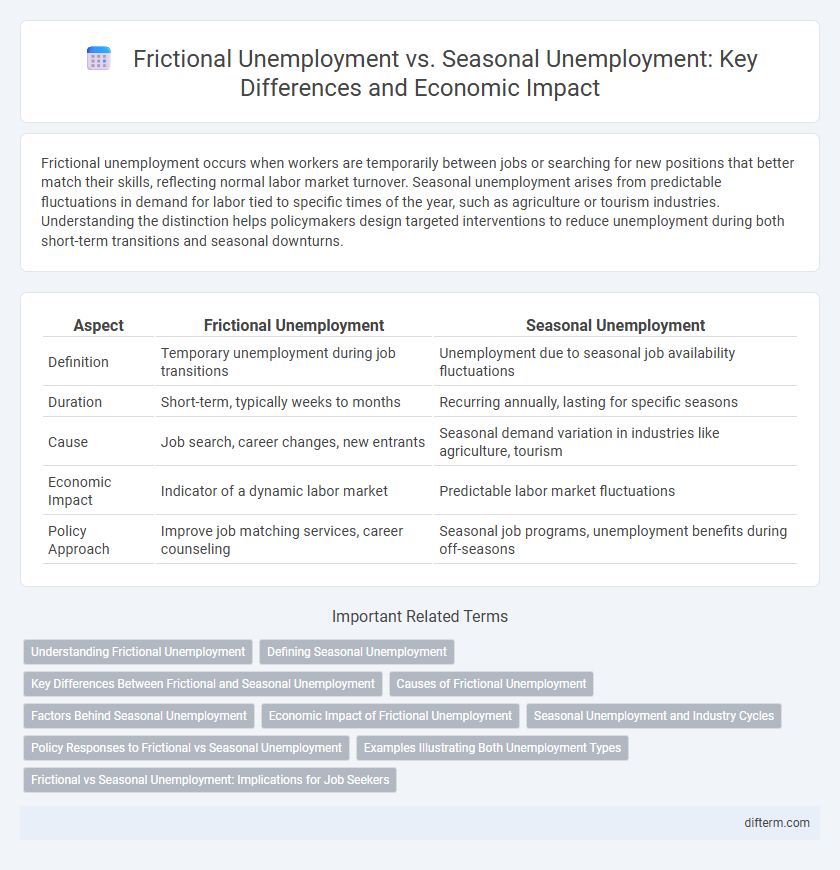Frictional unemployment occurs when workers are temporarily between jobs or searching for new positions that better match their skills, reflecting normal labor market turnover. Seasonal unemployment arises from predictable fluctuations in demand for labor tied to specific times of the year, such as agriculture or tourism industries. Understanding the distinction helps policymakers design targeted interventions to reduce unemployment during both short-term transitions and seasonal downturns.
Table of Comparison
| Aspect | Frictional Unemployment | Seasonal Unemployment |
|---|---|---|
| Definition | Temporary unemployment during job transitions | Unemployment due to seasonal job availability fluctuations |
| Duration | Short-term, typically weeks to months | Recurring annually, lasting for specific seasons |
| Cause | Job search, career changes, new entrants | Seasonal demand variation in industries like agriculture, tourism |
| Economic Impact | Indicator of a dynamic labor market | Predictable labor market fluctuations |
| Policy Approach | Improve job matching services, career counseling | Seasonal job programs, unemployment benefits during off-seasons |
Understanding Frictional Unemployment
Frictional unemployment occurs when workers are temporarily between jobs or entering the labor market for the first time, reflecting the natural job search process and matching inefficiencies. It contrasts with seasonal unemployment, which arises from predictable, recurring shifts in labor demand tied to specific seasons or industries. Understanding frictional unemployment helps economists measure the healthy churn within dynamic labor markets and design policies that reduce the duration of job searches.
Defining Seasonal Unemployment
Seasonal unemployment occurs when workers are temporarily out of jobs due to the predictable and recurring fluctuations in demand tied to specific seasons or calendar periods, such as harvest seasons or holiday retail periods. It differs from frictional unemployment, which refers to short-term joblessness as individuals transition between jobs or enter the labor market. Understanding seasonal unemployment is crucial for accurately analyzing labor market cycles and implementing targeted economic policies.
Key Differences Between Frictional and Seasonal Unemployment
Frictional unemployment arises from temporary transitions as workers search for new jobs matching their skills, often influenced by personal choice or career shifts, while seasonal unemployment occurs due to predictable fluctuations in labor demand tied to specific times of the year or industry cycles. Key differences include the duration, with frictional unemployment typically shorter and more dynamic, and the cause, where frictional is linked to labor market mobility and seasonal to industry-specific periods such as agriculture, tourism, or retail sectors. Understanding these distinctions helps policymakers design targeted interventions to reduce unemployment duration and optimize workforce allocation.
Causes of Frictional Unemployment
Frictional unemployment arises primarily from the time individuals spend transitioning between jobs due to factors such as job search, relocation, and career changes, reflecting a dynamic labor market. Causes include voluntary job separations, new entrants like recent graduates, and mismatches in information about available positions. Unlike seasonal unemployment, which results from predictable fluctuations in demand based on seasons, frictional unemployment is a natural part of the economy's adjustment process to evolving job opportunities.
Factors Behind Seasonal Unemployment
Seasonal unemployment arises from predictable fluctuations in demand for labor tied to specific times of the year, such as agriculture, tourism, and retail sectors during holidays. Key factors include climate changes, holiday seasons, and industry cycles that cause temporary reductions in job availability. Understanding these patterns helps businesses and policymakers prepare for recurring employment shifts distinct from the constant labor market turnover seen in frictional unemployment.
Economic Impact of Frictional Unemployment
Frictional unemployment represents short-term joblessness during transitions between jobs, reflecting a dynamic labor market that allows workers to find better matches and improve productivity. This type of unemployment typically leads to minimal economic disruption since it facilitates efficient allocation of human capital and supports wage growth over time. Businesses benefit from frictional unemployment by gaining access to labor better suited to their needs, which enhances overall economic efficiency and innovation.
Seasonal Unemployment and Industry Cycles
Seasonal unemployment arises from fluctuations in demand for labor during specific periods, heavily impacting industries such as agriculture, tourism, and retail where economic activities are tied to particular seasons. Industry cycles often amplify this effect as certain sectors experience peak production times followed by off-seasons with reduced labor needs. Understanding the relationship between seasonal unemployment and industry cycles is crucial for policymakers aiming to design targeted employment strategies and stabilize economic performance.
Policy Responses to Frictional vs Seasonal Unemployment
Policy responses to frictional unemployment emphasize improving job matching through enhanced labor market information systems and career counseling services, while facilitating workforce mobility and reducing search frictions. Seasonal unemployment policies focus on diversifying local economies, offering temporary financial assistance, and promoting retraining programs during off-peak periods to stabilize income and employment. Tailored strategies address the distinct causes of each unemployment type, optimizing resource allocation and labor market efficiency.
Examples Illustrating Both Unemployment Types
Frictional unemployment occurs when workers transition between jobs, such as a software developer leaving one company to find a better role or a recent college graduate searching for their first position. Seasonal unemployment arises from predictable, recurring fluctuations in employment, exemplified by agricultural workers hired only during harvest seasons or retail employees laid off after holiday sales peak. Understanding these examples highlights how frictional unemployment reflects short-term job search processes, while seasonal unemployment depends on calendar-based labor demand changes.
Frictional vs Seasonal Unemployment: Implications for Job Seekers
Frictional unemployment occurs as workers transition between jobs, often reflecting voluntary job changes or new entrants into the labor force, leading to short-term employment gaps. Seasonal unemployment, in contrast, arises from predictable fluctuations in labor demand related to specific times of the year, such as agriculture or tourism sectors facing off-peak periods. Understanding these differences helps job seekers tailor their strategies: frictional unemployment encourages skills development and networking for smoother transitions, while seasonal unemployment demands planning for income variability and securing off-season opportunities.
Frictional unemployment vs Seasonal unemployment Infographic

 difterm.com
difterm.com